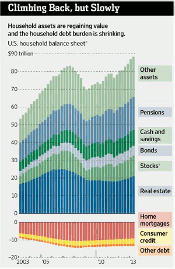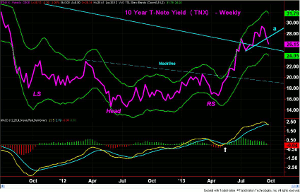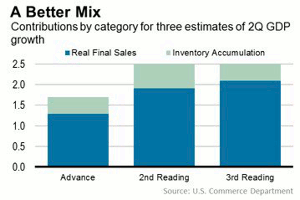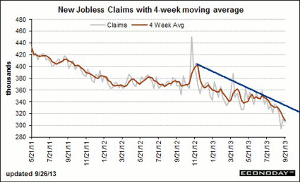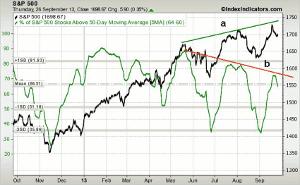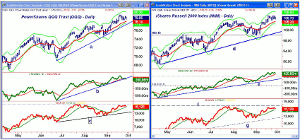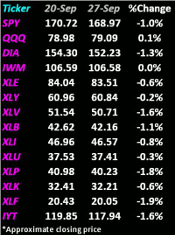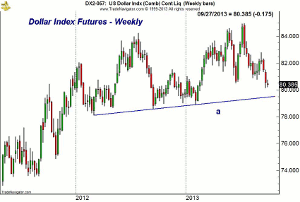The S&P 500 is up 18% so far in 2013, but the Washington debt ceiling crisis has many people, including MoneyShow’s Tom Aspray, wondering if the stock market can hold these gains through the rest of the year.
As we approach another financial crisis in Washington, a scene that may be repeated next month, many are wondering whether or not they should be invested in stocks. The year to date gain in the Spyder Trust (SPY) of over 18.4% is well into the double-digit territory I expected at the end of 2012. Of course the question is how will stocks do in the fourth quarter? But will the market be able to hold these gains until the end of the year?
January’s 4.6% gain reinforced the positive view and, as I noted on February 1st, “that since 1929, a higher January close in the S&P 500 has resulted in an average 13% gain.” In that column, I pointed out that the best prior January was in 1997 when the S&P 500 finished up 31% for the year. There were several wide swings that year, as one had to endure a 13.6% drop in October, before the S&P 500 finished the year near its highs.
I also shared examples of 2001 and 1994 when strong January gains still resulted in a down performance for the year. I do not think this will happen in 2013, as the patterns of those years were much different. If we do get weekly sell signals, we will give up a chunk of the current gains before moving higher into the end of the year.
Asset values have improved markedly from the recession lows, as this WSJ chart illustrates. Pensions, as well as cash and other assets, have moved above the pre-crash highs. Stocks and bonds are close to the 2007 highs, as is real estate. Another positive is that the debt levels have improved.
Of course, the concern now is that the impasse in Washington will derail the recovery and that the higher mortgage rates will slow down the housing markets. As the Wall Street Journal pointed out, “Economic output would actually have contracted in both late 2012 and early 2013 if it hadn't been for solid gains in consumer spending.”
Consumer sentiment has had a rough month, as Friday’s release of the final month reading from the University of Michigan was 77.5. It had been above the 80 level for the past several months. The positive uptrends for both consumer sentiment and consumer confidence are still intact
The bond market appears to have had a pivotal trend change since the FOMC announcement, as yields on the 10-Year T-Note (TNX) have dropped from just under 3% to 2.614% on Friday. I have been looking for a pullback in yields for the last two months, but it certainly took longer than I expected.
The weekly chart shows the completion of the reverse head and shoulders bottom formation in May that was supported by the positive signals from the MACD. The break of initial support, line a, is consistent with a further decline in yields and the MACD is now moving into the sell mode. Therefore, a further decline to the 2.40% area is clearly possible.
The news out of the Euro zone continues to improve, but their major stock markets, like the German DAX, have also pulled back from their all-time highs. The GDP numbers out of China were also better than expected, and while the emerging markets are below their September highs, they still appear to be in the bottoming process.
NEXT PAGE: What to Watch
|pagebreak|
It was another mixed bag of economic news in the US, as the flash PMI Manufacturing Index came in at 52.8, below the 54 reading that most were expecting. The Richmond Fed Manufacturing Index was unchanged and Consumer Confidence dropped to 79.8 from a prior month’s reading of 81.8. The Durable Goods and New Home Sales were both better than expected, even though the prior month’s Durable Goods were revised downward.
As the chart indicates, the third estimate for GDP was unchanged at 2.5%, which was well above the economist’s estimate of 1% growth at the start of the second quarter. The third quarter forecast is for growth of 2.3%.
This week we will get several new readings on the health of the manufacturing sector. Monday, we get the Chicago PMI and the Dallas Fed Manufacturing Survey, followed on Tuesday by the PMI Manufacturing Index, along with the ISM Manufacturing Index. Weak numbers, combined with a shutdown of the government, could further frighten investors.
This, of course, is the week for the monthly jobs report, which is preceded on Wednesday by the ADP Employment Report. Last week’s jobless claims were better than expected, as the chart shows a clear downtrend in both the raw data and the 4-week average. We will get new numbers on Thursday, along with Factory Orders, and the ISM Non-Manufacturing Index.
What to Watch
Last week I wondered “How Long will the Fed High Last?” So far, the answer seems to be not too long. I was looking for stocks to turn around by the middle of the week and Thursday’s close, along with the strong earnings from Nike Inc. (NKE) was encouraging.
The selling, however, resumed overnight, as most stocks had a solid week on the downside The S&P futures and Spyder Trust (SPY) triggered weekly low close doji sell signals. The cash S&P 500 and Nasdaq 100 did not.
Several of the positive technical signals I reviewed last week have deteriorated or reversed course, as the short-term momentum is negative. So far, the selling has not been heavy, so the A/D lines, for the most part, have not broken important support.
It is a concern that the five-day MA of the S&P 500 stocks above their 50-day MAs has turned down before reaching its downtrend, line b. It is now back below the mean at 66 and is clearly diverging from the price action, line a.
Still, there are quite a few stocks that have just moved out of nice bottom formations like the homebuilders. They do not look ready to drop below the August-September lows, but need a good up day to turn the momentum positive.
Also on the Positive side is the Dow theory, as both the Dow Industrials and Transports made new highs, along with the Mass Index that shows no signs yet of a major trend change.
The sentiment has turned more cautious, but 36.5% of the individual investors are still bullish, which is still on the high side. The neutral investors have risen from 25.2% last week to 33.3% this week, suggesting that some have moved to the sidelines.
The daily chart of the NYSE Composite shows that it dropped back to its 20-day EMA on Friday, and now needs a close back above the 9700 level to reverse the short-term downward trend. The daily starc- band is at 9569 with stronger support at 9415, line a. This is approximately 2.7% below Friday’s close.
The McClellan oscillator is now in a short term downtrend after breaking its uptrend, line b, early in the week. It is still above the zero line with further support, line c, at -100.
The daily NYSE Advance/Decline line did form a positive divergence at the lows, which was confirmed by the move through its downtrend, line d. The A/D line did not confirm the new price highs and is now on the verge of dropping back below its WMA.
NEXT PAGE: Stocks
|pagebreak|S&P 500
The Spyder Trust (SPY) closed the week right on its 20-day EMA, as the short-term support in the $170-$171.20 area was broken early in the week. The daily starc- band is at $166.90 with the uptrend, line f, in the $166 area.
The 20-week EMA, which was tested in August, is now at $165.34, with the weekly starc- band now at $160.23.
The daily on-balance volume (OBV) dropped below its WMA last week and the WMA has now flattened out. It will be important that the OBV moves strongly above its WMA on any rally this week, since it did confirm the recent highs. The OBV has stronger support at line g. The weekly OBV (not shown) is still above its WMA and did confirm the highs.
The daily S&P 500 A/D line closed the week below its WMA after also confirming the post FOMC price highs. It is still above the support from April and June at line h.
The preliminary monthly pivot for October is at $169.02 with daily resistance now at $170.17. A close above this week’s high at $170.65 would be a short-term positive.
Dow Industrials
The SPDR Dow Industrials (DIA) opened below the prior week’s lows, which is not a good sign. It is still the weakest of the major averages. It closed the week on next month's pivot at $152.28, with further support in the $150-$151 area, which includes the 20-week EMA. The weekly starc- band is considerably lower at $144.73.
The Dow Industrials A/D line (not shown) has declined steadily over the past seven days and has closed well below its flat WMA.
The daily OBV has dropped below its WMA, while the weekly is still above its WMA. Therefore, the multiple time frame OBV analysis is now mixed and neither confirmed the new price highs.
There is initial resistance now at $153.50-$154 with the daily starc+ band above $155.
Nasdaq-100
The PowerShares QQQ Trust (QQQ) just slightly higher last week, but the relative performance analysis still indicates that it is a market leading sector. There is initial support now in the $77.50-$78 area with further at $76-$76.50. The monthly pivot for October is at $78.13.
The daily OBV did confirm the price highs, but is now testing its WMA and the uptrend from the June lows, line b. A drop below the August lows would be more negative. The weekly OBV and RS analysis (not shown) are positive with the RS line rising sharply.
The daily Nasdaq-100 A/D line is still in an overall uptrend, but has lost some upside momentum. It failed to move above the august highs on the last rally, which is a concerning sign. The A/D line has next good support at line c.
A daily close above the $80 would definitely reassert the uptrend with October’s monthly projected high currently at $82.27.
Russell 2000
The iShares Russell 2000 Index (IWM) also held firm all week and closed well above the still rising 20-day EMA at $105.31. The daily starc- band is at $104.39 with major support in the $100-$102 area.
The daily OBV, and weekly on balance volume, both have confirmed the new highs and are above their still rising WMAs.
The Russell 2000 A/D line turned positive in early September by moving above its WMA, but has failed to make new highs with prices. This divergence would be confirmed by a drop below the August lows and support at line g.
The daily relative performance made new highs last week with short term resistance now at $107.62. The daily starc+ band is at $109.07.
NEXT PAGE: Sector Focus, Commodities, and Tom's Outlook
|pagebreak|Sector Focus
The iShares Dow Jones Transportation (IYT) gave up much of the prior week’s gains, as it was down about 1.8% on the week. There is next good support in the $116-$116.50 area. The current value for October’s monthly pivot is at $116.78. The still rising 20-week EMA is at $114.16.
The daily studies are declining, but are still positive, as they are above their rising WMAs.
Twelve of the fourteen ETFs in the weekly performance table were lower last week with the Sector Select SPDR Consumer Staples (XLP), Sector Select SPDR Health Care (XLV) and Sector Select SPDR Financials (XLF) showing the largest losses, ranging from 1.6% to 1.9%.
The iShares Russell 2000 (IWM) was flat for the week, while the PowerShares QQQ Trust (QQQ) was up slightly. The Sector Select SPDR Consumer Discretionary (XLY) was just 0.2% lower, which may be a sign that the consumer is in better spending mood than most think.
The weekly studies on my favored sector ETFs are generally positive, but some could turn negative with a sharply lower close this week.
Dollar Index: The dollar index futures hit a high just below 85.00 in July and has since dropped down to the 60 area. There is weekly trend line support in the 79.50 area, line a, and a drop below the year’s low at 78.91 would be a negative sign.
Crude Oil
Crude oil closed down another $1.90 a barrel last week but is still holding above the important support for the November contract at $101.40. There is further support in the $99 area. The weekly OBV has dropped below its WMA but did confirm the recent highs. There is first strong resistance in the $108 area.
Precious Metals
Trading in the precious metals was quieter last week, but both the Spyder Gold Trust (GLD) and the Market Vectors Gold Miners (GDX) were a bit lower. There are signs of a bottom from the technical studies, but a close above the highs of the past two weeks is needed to confirm.
The Week Ahead
The stock market bears were in charge again last week, as the possibility of a government shutdown and concerns over the debt ceiling continue to limit the buying. Still, the selling was not that heavy, but that could change if we do not get a deal by Monday and the government does shutdown.
The posturing over the debt ceiling has me even more perplexed since this is money we have already spent. Maybe on Monday I will call Verizon and tell them I don’t want to pay last month’s FIOS bill—I wonder how that would go over?
The flood of economic reports and the start of the earning season will give the market plenty to think about. Some are looking for sharp improvement in revenues which would surprise some of the bears.
The pullback in the emerging markets still appears to be part of the bottoming process, and I will be watching them carefully for signs that the selling is over. I continue to recommend the dollar cost averaging strategy in the Vanguard FTSE Emerging Markets ETF (VWO), as discussed in a previous Week Ahead column.
I am hopeful that a government shutdown will be avoided, as a very positive close early in the week, with three to one or better positive A/D ratios, should signal a resumption of the uptrend as it did last December. If instead we get a weak rally then I will recommend that some of the protective stops be tightened.
Don't forget to read Tom's latest Trading Lesson, Shop Here for Winners This Fall.

